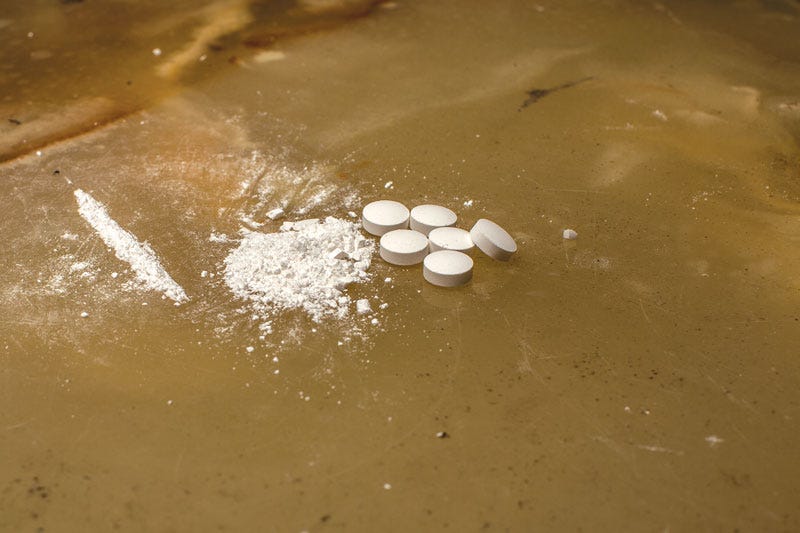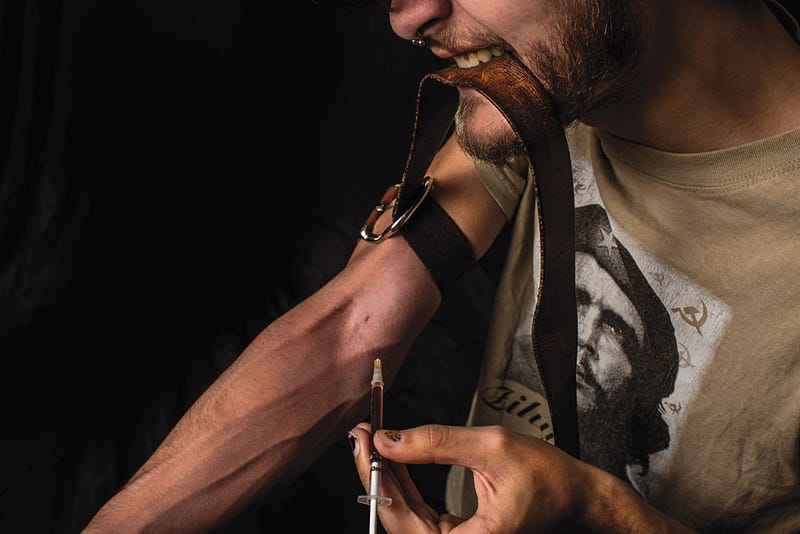The Pill Game
STORY BY BEATRICE HARPER
photo illustrations by Jake Parrish
Living life sober one day at a time
His hands tremble as he clutches the pill bottle; little white ovals clatter into his strong, clammy palm. One, two, three, four … no, five — five will put him in a calm state of mind for the day. Twenty minutes later, as a customer screams at him over a misunderstanding, he smiles, his dark eyes lighting up. On first glance, he appears composed, well dressed in a crisp shirt and slacks, an air of charismatic confidence about him, but upon deeper examination into his daily rituals, one would realize this is the life of a functioning OxyContin addict.
Since 1996, when OxyContin was first introduced to the pharmaceutical market as a pain reliever, rates of Oxy use have grown exponentially. In more recent years, Oxycodone, a generic version of OxyContin, was altered to be tamper proof — meaning that for those cracking the pills to instantly release the drugs numbing effect, it would no longer work to satisfy their cravings.

Today, Mike, 35, is a recovering addict that has struggled with addiction since he was 27 years old.
Mike’s use initially began as a way to combat the stressors of being thrust into a high-powered management position that he simply was not ready for. An ex-military friend with a lifetime Oxy prescription, following a wartime injury, suggested Oxy as an alternative to managing work-related stress. From there, Mike’s use increased from being a coping mechanism at work to a full-fledged addiction.
Within eight months, he was taking Oxy five days a week and experiencing withdrawal symptoms when not using. He lost compassion for his employees and only cared that the company was meeting its monetary goals. If he didn’t have opiates in his system, he couldn’t manage.
“As long as my needs were being met — so long as I had Oxy,” Mike says, “I didn’t care about anything.”
As the medical world began to catch on to recreational misuse of Oxy, restrictions were enforced to make abusing the drug more difficult and Oxy became harder to attain, Mike says. He contacted over 20 dealers, hearing the same words from each one — there was no more Oxy to be had, but they did have heroin.
“There was no question, there was no thinking — it was either get sick, or make the switch to heroin,” Mike says.
Twenty eight states displayed death rates from prescription opiates as having declined by 6.6 percent between 2010 and 2012. In the same years, lethal heroin overdoses climbed from 1,779 cases to 3,635, according to the Centers for Disease Control and Prevention.
Known for its euphoric numbing properties, the Drug Enforcement Agency classifies heroin as a schedule I controlled substance, having a high potential for abuse with no accepted medical qualities.
“I knew that I was either going to die — or get sober.”
In prior jobs Scott Martinez, a risk reduction specialist at Western’s Prevention and Wellness Center, had patients who sold or gave away their prescribed opiate-based pharmaceuticals — such as Oxy or Hydrocodone — in exchange for heroin, or for money to buy it.
Addicts will sometimes intentionally injure themselves to receive prescriptions, says Lex Rivers, regional manager of Catholic Community Services of Whatcom County’s recovery center. Whereas pharmaceuticals are amply prescribed but expensive to fill, heroin is relatively cheap, Rivers says. The Center for Rural Pennsylvania released the report “Heroin: Combating this Growing Epidemic in Pennsylvania,” which stated that heroin is cheaper to purchase than beer.
Heroin builds a tolerance, and doses increase over time to achieve the same intense hight as the first time, Rivers says. If addicts attempt to quit, their body feels sick from the withdrawal of the drug. Each use reprograms the body into perceiving heroin in the body as being normal, he says. The body goes from being numb all the time to experiencing withdrawals feelings, which can be incredibly painful both physically and mentally.
Mike’s growing addiction led him to ask his parents for money, claiming it was for a mortgage payment, although he used it to get high, he says. His ex-wife found a bankcard that didn’t belong to their shared account, and when she questioned him about it he covered it up with lies. Mike lost his wife, his little girl, his house, his life savings, his friends and many jobs to his addiction.

Mike’s dealer, a friend that had introduced him to his ex-wife, finally contacted her, worried about the amount Mike was using. His family intervened and eventually admitted Mike into rehab. Although the clinic’s method of pushing people through the system was not what he needed to get clean, Mike says.
Mike relapsed and fell into a darker place. He hit rock bottom when he realized he was using heroin as an escape to get away from all the people he’d hurt, and lost, from getting high. He was on the brink of committing suicide to get away from the pain, because when he wasn’t high the burden was simply too much to bear, Mike says.
“I knew that I was either going to die — or get sober,” Mike says.
Mike chose to live. The decision was not an easy one, but he found a treatment center that helps patients attain their personal goals. He was able to focus on investing in his health and long-term happiness. He sat in a room for the 72-hour withdrawal period, alone with his pain he refused to take medicine prescribed to recovering addicts to help with the pain. It was difficult, but it was the reality he needed, Mike says.
“I’m still exploring myself and my spirituality, but I am very, very happy with what I have in my life,” Mike says.
Heroin cravings activate areas in the brain that control dopamine, or the release of pleasure, Martinez says. For a recovering addict, the brain must be reprogrammed to learn to receive pleasure from day-to-day activities instead of drugs.
“They [addicts] have to learn how to find natural, normal means of attaining happiness,” he says, “As they are locked into a world of perpetually using again and again in order to keep withdrawal symptoms away, or to keep from getting sick.”
Mike’s recovery has not been easy, he still experiences ramifications of his past choices. His credit is in the red, he spent an enormous amount of money on drugs and he lost many relationships. But he learned life isn’t about material things, it’s about what a person can do to better the world and be more conscious of what’s going on. He’s learned to give love without expecting anything in return, to live life with integrity and to be a man, he says.
“I wake up each day with purpose — each day is different, but it’s to be the best person I can be, to find joy in the little things in life,” he says.
Today, nearly 11 months clean, Mike is positive and continuing to work on remaining sober. He has cravings, not for heroin anymore, but for simple things that he will never be able to have so long as he is sober, such as drinking a beer at the end of a long day.
“When you live life in addiction you only have one thing on your mind,” Mike says, “And that’s where, and how, you’re going to get your next fix — you don’t have time to see the beauty in life.”
In the end, his hope for living a positive existence and changing the world with his outlook keeps him going, as he takes sobriety one day at a time.
